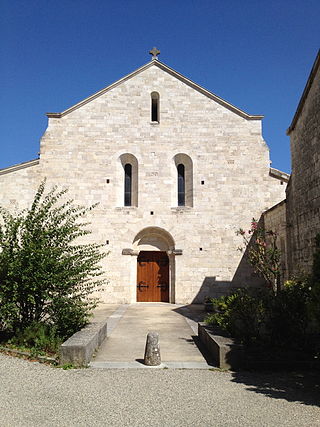
The Abbey of Notre-Dame des Dombes (French : Abbaye Notre-Dame-des-Dombes) is a former Trappist monastery located in Le Plantay in the Dombes region, in the Ain department of eastern France. It is now occupied by members of the Chemin Neuf movement.

The Abbey of Notre-Dame des Dombes (French : Abbaye Notre-Dame-des-Dombes) is a former Trappist monastery located in Le Plantay in the Dombes region, in the Ain department of eastern France. It is now occupied by members of the Chemin Neuf movement.
The monastery was established by 44 monks from Aiguebelle Abbey in 1863, on the invitation of Mgr Pierre-Henri Gérault de Langalerie, bishop of Belley, with the aim not only of evangelizing the country, but also of draining the swamps of the Dombes, so as to improve agriculture and fishing and raise the standard of living of the inhabitants.
The importance of the abbey grew quickly, and it was successful in its intended purposes.
In 1937 Paul Couturier launched the Dombes Group (Groupe des Dombes), a francophone ecumenical group consisting of equal numbers of Roman Catholic and Protestant theologians, which met between 1968 and 1997 in the abbey.
During World War II the monks worked with the Resistance and helped many people, especially Jews. There were many visits by the Gestapo; on 2 May 1944 two monks were executed, and others arrested. For the community's actions the abbey was awarded in 1946 the Legion of Honour. [1]
In 2001, there were very few monks remaining, who asked the Chemin Neuf Community to come and replace them in their mission of prayer and welcoming visitors.

Val-Dieu Abbey is a former Cistercian monastery in Wallonia in the Berwinne valley near Aubel in the Pays de Herve.

The Abbey of Notre-Dame des Neiges or Our Lady of the Snows is a Cistercian monastery in the Ardèche département of south-central France. The former Trappist monastery has been resettled by Cistercian nuns in 2022. The abbey was built in 1850, located on the territory of the commune of Saint-Laurent-les-Bains, about one and a half miles east of the village of La Bastide-Puylaurent (Lozère).

Aiguebelle Abbey is a Trappist monastery situated in the communes of Montjoyer and Réauville in the département of Drôme, on the borders of the Dauphiné and of Provence, France.

Sept-Fons Abbey, Notre-Dame de Sept-Fons or Notre-Dame de Saint-Lieu Sept-Fons is a Trappist monastery at Diou in Bourbonnais in the diocese of Moulins in France. Around ninety monks currently live in the monastery, many of whom are novices sent from monasteries around the world.

Fontgombault Abbey, otherwise the Abbey of Notre-Dame, Fontgombault, is a Benedictine monastery of the Solesmes Congregation located in Fontgombault in the département of Indre, in the province of Berry, France. It was built in the Romanesque architectural style. The monastery, founded in 1091, was dissolved in 1791 and refounded in 1948.
Tamié Abbey is a Cistercian monastery, located in the Bauges mountain range in the Savoie region of France.
Gerald of Sales was a French monastic reformer from Salles, Lot-et-Garonne near Bergerac, Dordogne in the south-west of France. His feast day is on April 20.

Vaux-de-Cernay Abbey is a former Cistercian monastery in northern France (Île-de-France), situated in Cernay-la-Ville, in the Diocese of Versailles, Yvelines. The abbey was abandoned during the French Revolution and fell into partial ruin. Most of the buildings, except for the church, were restored in the late 19th century by Charlotte de Rothschild, and the property is now a hotel.

Scourmont Abbey is a Trappist monastery on the Scourmont plateau, in the village of Forges which is part of Chimay in the province of Hainaut, Belgium. The abbey is famous for its spiritual life and for running the Chimay Brewery, one of the few producers of Trappist beer.

Melleray Abbey was a Cistercian monastery, founded about the year 1134. It was situated in La Meilleraye-de-Bretagne in the vicinity of Châteaubriant in Brittany, in the present Loire-Atlantique, France, and in the Diocese of Nantes. Between 1817 and 2016 it was a house of Trappist monks. Since 2016 it has been used by the Chemin Neuf Community.

The Chemin Neuf Community is a Catholic community with an ecumenical vocation. Formed from a charismatic prayer group in 1973, it has 2,000 permanent members in 30 countries, and 12,000 people serving in the community missions. Its main founder is the Jesuit father, Laurent Fabre.

Vauclair Abbey otherwise Vauclerc Abbey was a Cistercian monastery founded in 1134 by Saint Bernard of Clairvaux at the request of Barthélemy de Jur, bishop of Laon. It was located in what is now the commune of Bouconville-Vauclair, department of Aisne, France.

Igny Abbey or Val d'Igny Abbey is a Cistercian abbey located in Arcis-le-Ponsart, Marne, France. It was founded in 1128 for Cistercian monks, dissolved in 1791 during the French Revolution, re-established in 1876 for Trappist monks, destroyed in 1918, reopened in 1929 for Trappist nuns and modernised in 2008–12 to accommodate three or four pre-existing communities.

The Abbey of Our Lady of Atlas is a Catholic monastery of Trappists, inaugurated on March 7, 1938, in Tibhirine, close to Médéa, in Algeria.

St. Paul's Abbey, Oosterhout, also Oosterhout Abbey is a former Benedictine abbey in Oosterhout, North Brabant, the Netherlands.
Abbecourt Abbey is a former Premonstratensian monastery in Orgeval, Yvelines, France.

Fontenelles Abbey or Les Fontenelles Abbey was an Augustinian monastery in the former commune of Saint-André-d'Ornay, in the Vendée, France.
![]() Media related to Abbaye Notre-Dame-des-Dombes at Wikimedia Commons 46°02′17″N5°05′47″E / 46.0380°N 5.0963°E
Media related to Abbaye Notre-Dame-des-Dombes at Wikimedia Commons 46°02′17″N5°05′47″E / 46.0380°N 5.0963°E